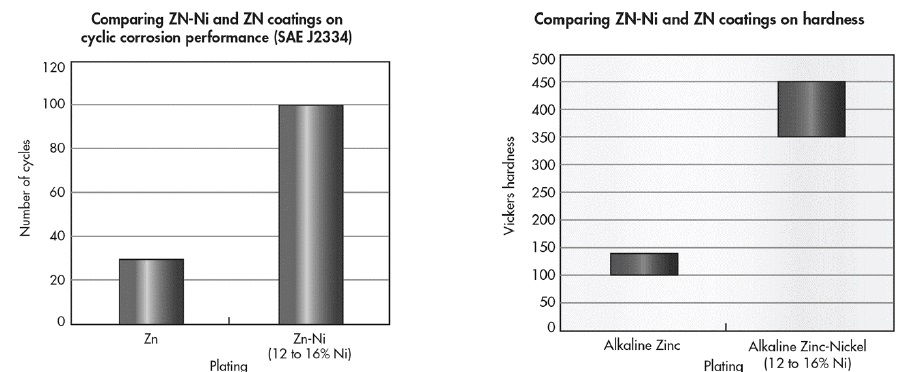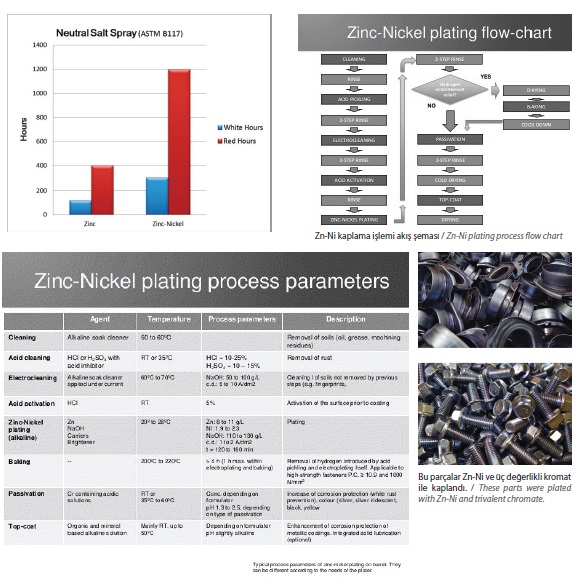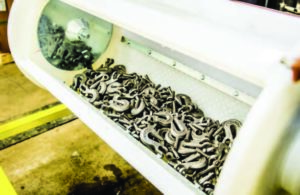Which is the Best Plating Practice For Zn-Ni Deposition? Barrel or Rack Plating
Zn-Ni Plating
The automotive, agricultural equipment and other durable goods industries continue to focus heavily on zinc nickel plated deposits. As zinc nickel plating chemistries have improved, the cost to operate compared to the performance benefits has become much more attractive.
Zinc-nickel platings were developed as a result of increasing requirements with regard to corrosion protection, in particular from the automotive industry, against exposure to temperature, road salt and climatic conditions.
Zinc-nickel platings are normally used if the traditional zinc-plating process is insufficient, due to high temperatures or aggressive environmental conditions.
The Ni incorporation rates amount to approximately 10-15%. Research has found that the most influential component of the overall nickel content is control of the percentage of nickel content in the bath. Current density and temperature also play a role in the overall process.
The Zn-Ni surfaces offer optimal cathodic corrosion protection and are highly resistant to thermal loads (up to 120°C). This type of surface finish is usually used on steel, ferrous cast components and powdered metals.
Depending on the number and geometry of the metallic parts, electroplating can be applied in rack type and barrel type coating baths. Choosing the right electroplating method is essential for achieving optimal results and minimizing the risk of damage to the finished product.
Each offers several advantages, as well as the points that the customer needs to consider. The coating composition and type are determined depending on the working environment conditions. Coating corrosion (salt spray) performance is controlled by thickness and chemical composition.
Thicknesses vary between 5-25 microns depending on working environment conditions. Zn-Ni alloy coatings are electroplated on carbon steel as a higher protective coating in a process similar to the way zinc coatings are applied.
Zn-Ni coatings typically consist of 8 to 14 μm layer of 12 to 16% nickel alloy next to the substrate topped by a 0.06 to 0.15 μm trivalent passivate layer and a 0.5 to 4.0 μm top coat layer.
There the similarities end: Zn-Ni alloy coating significantly exceeds the protection offered by other coatings in three main areas: It offers greater corrosion protection, It provides more wear resistance in moving parts, It limits thermal stress to parts subjected to higher operating temperatures.


A hard, thin-film Zn-Ni coating has a consistently smooth finish that increases wear resistance both through its hardness and by producing a surface that virtually eliminates irregularities, reducing both friction and opportunities for abrasion.
On the Vickers hardness scale, parts coated with Zn-Ni reach 450, compared to less than 150 for zinc-coated parts. In SAE J2334 Cyclic Corrosion tests, a much more stringent test than a simple salt test, parts coated with Zn-Ni outperform zinc coated parts by a factor of four.

What is Barrel Plating?
inside a barrel typically constructed of polypropylene. The barrel contains center bars that conduct the electrical current. The barrel rotates (5-7rpm) slowly while immersed in the electrolytic plating solution.
This causes the parts to tumble or “cascade,” which provides an even, uniform coating application. Typical barrel plating applications include enhancing corrosion protection, increasing aesthetic appeal and producing an engineering finish that protects the parts against wear and tear.
Barrel plating offers a cost-effective means of plating a high volume of small, durable parts such as stampings and fasteners. It also works well for plating parts of various shapes and sizes.
Barrel plating requires a smaller investment in equipment and is less labor-intensive than rack plating, which ultimately results in a lower process cost to the customer.
In combination with higher levels of efficiency, several advantages to using the barrel plating method: • Large, rapid volume production in comparison to rack plating as a result is faster for production.


It requires less floor space and lower equipment investments as a result, saving businesses money.
• Less labor is required compared to the rack plating process.
• The entire plating process takes place inside of the barrel or vessel therefore only one person is needed per barrel.
• Barrel plating is versatile: plating several objects at the same time is highly achievable.
• The cascading motion produces a more uniformed metal finish in conclusion, the object has an even finish.
• Agitation of the tanks solutions eliminate stratification and produces a homogeneous bath.
What is Rack Plating?
Rack plating differs from barrel plating in that the parts are affixed to metal racks with screws, wires or spring fingers. This causes the parts to remain stationary upon immersion of the metal rack into the plating solution.
Consequently, metal platers prefer rack plating for delicate parts that might not be able to withstand the tumbling or cascading action produced by barrel plating. Rack plating also works well for large or complex components.
In addition to affording increased protection against damage to parts, the rack process can plate contours and intricate shapes more efficiently. Rack plating is the preferred choice in industries where a high-quality finish is paramount such as military and defense, automotive, medical and electronics.
Disadvantages of rack plating include the higher cost and increased labor requirements. In many cases, it may be necessary to design and manufacture a customized rack for specialized applications. When evaluating at a pro spective job, some of the key factors to consider are:
• Part geometry,
• End use,
• Base material,
• Part volume,
• Throughput,
• Type Of Process (Electroless, Electrolytic, Immersion
Only, etc).
ZnNi Plating Applications
• Underhood components,
• Tubing-fuel and hydraulic parts,
• Parts that will be bent, crimped, rolled, or staked after plating,
• Tight plating tolerances,
• Automotive Industry: used when corrosion protection is required that is superior to standard zinc plating,
• Electrical Transmission Industry: used for anchors, cleats, bolts, and coaxial cables,
• Fastener Industry: used for improved corrosion protection and a cadmium replacement,
• Aerospace Industry: used to minimize galvanic corrosion when mating stainless steel and aluminum,
• Defense Industry: used as a cadmium replacement.
ZnNi Plating Advantages
• Excellent corrosion resistance, generally 5X better than pure zinc,
• Neutral salt spray results consistently achieve 250 hours to white,
• 1200+ to red with trivalent chromium passivates,
• Excellent corrosion resistance at high temperatures,
• Highest abrasion resistance of all zinc alloysctive replacement for Cadmium Plating,
• Useful for avoiding galvanic corrosion when plated parts are in contact with aluminum,
• Clear and black trivalent passivates can be applied over zinc nickel.
Dr. Ekrem Altuncu – ETSA / TESLAB – Sakarya Üniversitesi, Teknoloji Fakültesi, Metalurji ve Malzeme Müh. Bölümü – Sakarya University, Technology Fac., Metallurgical and Materials Eng. Dept.
***Electroplating is a process that requires skill, experience and the right equipment.





